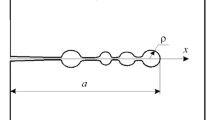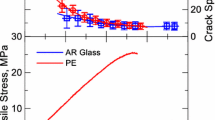Abstract
Physical simulations of cement-based composites containing “fiber-bridged cracks” were prepared using insulating right cylindrical plastic discs at a fixed volume fraction and each disc was pierced through by different numbers and/or different lengths of perpendicular steel fibers. All the discs were z-axis aligned, with the axis of rotation of the disc parallel to the z-axis of the sample, and placed at random positions within the composites. The conductivity of the composites were measured by AC-impedance spectroscopy (AC-IS) to quantitatively separate the effects of the conductive fibers and insulating cracks on the composite conductivity when they coexist in a large number. Using a known orientation of both inclusions, in the form of “fiber-bridged cracks,” will serve to verify the accuracy and the applicability of using each of their separated effects to predict each of their orientations. Compared to the low-frequency resistance of the plain matrix, the insulating cracks increased both the low-frequency and high-frequency resistances of the composites. The effect of the bridging conductive fibers, on the other hand, could be observed only through the high-frequency resistance, that was lower than the low-frequency resistance of the composites. Based on the intrinsic conductivity approach, the important parameters of the cracks and the fibers that determine the magnitude of change in the resistance are their aspect ratios, volume fractions, and their orientations with respect to the direction of measurement. Good agreements for the separated effects of each inclusion were obtained from the comparison of the measured AC-IS responses and the theoretical calculations. The understanding of the resistance change in the fiber-bridging area helps enable the use of AC-IS as a health-monitoring technique during the early stage of mechanical damage of the composites. It should be noted that although cement paste is used as the matrix material in the present work, the AC-IS approach established is equally applicable to other composites with moderately conductive matrix and within the dilute regime to avoid the percolation behavior of the inclusions.














Similar content being viewed by others
References
Dresher WH (1969) The age of fibers. JOM J Min Met Mat S 21(4):17–26
Døssland ÅL (2008) Fibre reinforcement in load carrying concrete structures. PhD Dissertation, Norwegian University of Science and Technology. ISSN: 1503-8181
Mo KH, Yap KKQ, Alengaram UJ, Jumaat MZ (2014) The effect of steel fibres on the enhancement of flexural and compressive toughness and fracture characteristics of oil palm shell concrete. Constr Build Mater 55:20–28. doi:10.1016/j.conbuildmat.2013.12.103
Narwal J, Goel A, Sharma D, Kapoor DR, Singh B (2013) An experimental investigation on structural performance of steel fibre reinforced concrete beam. Int J Eng Adv Technol 2(6):301–304 (ISSN: 2249-8958)
Chung DDL (2000) Composite materials for electronic functions, materials science foundations, vol 12. Trans tech Publications, Zurich
Chung DDL (2001) Applied materials science: applications of engineering materials in structural, electronics, thermal, and other industries. CRC Press, Boca Raton. ISBN 9780849310737
Azhari F, Banthia N (2012) Cement-based sensors with carbon fibers and carbon nanotubes for piezoresistive sensing. Cem Concr Comp 34(7):866–873
Ou J, Han B (2009) Piezoresistive cement-based sensors and self-sensing concrete components. J Intel Mat Syst Str 20(3):329–336
Wen S, Chung DDL (2007) Piezoresistivity-based strain sensing in carbon fiber-reinforced cement. ACI Mater J 104(2):171–179
Chacko RM, Banthia N, Mufti AA (2007) Carbon-fiber-reinforced cement-based Sensors. Can J Civ Eng 34(3):284–290. doi:10.1139/l06-092
Bontea DM, Chung DDL, Lee GC (2000) Damage in carbon fiber-reinforced concrete, monitored by electrical resistance measurement. Cem Conc Res 30(4):651–659. doi:10.1016/S0008-8846(00)00204-0
Zhu S, Chung DDL (2007) Theory of piezoresistivity for strain sensing in carbon fiber reinforced cement under flexure reinforced cement under flexure. J Mater Sci 42(15):6222–6233. doi:10.1007/s10853-006-1131-3
McCarter WJ, Starrs G, Chrisp TM, Banfill PFG (2007) Activation energy and conduction in carbon fibre reinforced cement matrices. J Mater Sci 42:2200–2203. doi:10.1007/s10853-007-1517-x
Chiarello M, Zinno R (2005) Electrical conductivity of self-monitoring CFRC. Cem Concr Comp 27:463–469. doi:10.1016/j.cemconcomp.2004.09.001
Shifeng H, Dongyu X, Jun C, Ronghua X, Lingchao L, Xin C (2007) Smart properties of carbon fiber reinforced cement-based composites. J Compos Mater 41(1):125–131. doi:10.1177/0021998306063378
Torrents JM, Mason TO, Peled A, Shah SP, Garboczi EJ (2001) Analysis of the impedance spectra of short conductive fiber-reinforced composites. J Mater Sci 36(16):4003–4012. doi:10.1023/A:1017986608910
Liu XM, Wu SP (2011) Study on the piezoresistivity character of electrically conductive asphalt concrete. Adv Mater Res 233–235:1756–1761. doi:10.4028/www.scientific.net/AMR.233-235.1756
Li GY, Wang PM, Zhao X (2007) Pressure-sensitive properties and microstructure of carbon nanotube reinforced cement composites. Cem Concr Comp 29(5):377–382. doi:10.1016/j.cemconcomp.2006.12.011
Anis A, Banthia AK, Bandyopadhyay S (2008) Synthesis and characterization of polyvinyl alcohol copolymer/phosphomolybdic acid-based crosslinked composite polymer electrolyte membranes. J Power Sour 179(1):69–80. doi:10.1016/j.jpowsour.2007.12.041
Woo LY, Wansom S, Ozyurt N, Mu B, Shah SP, Mason TO (2005) Characterizing fiber dispersion in cement composites using AC-Impedance Spectroscopy. Cem Concr Comp 27(6):627–636. doi:10.1016/j.cemconcomp.2004.06.003
Wansom S, Woo LY, Hoke SL, Mason TO (2006) Electrical mixing laws for composites with conducting and insulating discs by impedance spectroscopy. J Mater Sci 41(4):1089–1096. doi:10.1007/s10853-005-3645-5
Wansom S, Kidner NJ, Woo LY, Mason TO (2006) AC-impedance response of multi-walled carbon nanotube/cement composites. Cem Concr Comp 28(6):509–519. doi:10.1016/j.cemconcomp.2006.01.014
Wansom S, Janjaturaphan S (2014) Evaluation of fiber orientation in plant fiber-cement composites using AC-impedance spectroscopy. Cem Conc Res 45:37–44. doi:10.1016/j.cemconres.2012.11.003
Ford SJ, Shane JD, Mason TO (1998) Assignment of features in impedance spectra of the cement-paste/steel system. Cem Conc Res 28(12):1737–1751. doi:10.1016/S0008-8846(98)00156-2
Torrents JM, Mason TO, Garboczi EJ (2000) Impedance spectra of fiber-reinforced cement-based composites: a modeling approach. Cem Conc Res 30(4):585–592. doi:10.1016/S0008-8846(00)00211-8
Mason TO, Campo MA, Hixson AD, Woo LY (2002) Impedance spectroscopy of fiber-reinforced cement composites. Cem Concr Comp 24(5):457–465. doi:10.1016/S0958-9465(01)00077-4
Hixson AD, Woo LY, Campo MA, Mason TO, Garboczi EJ (2001) Intrinsic conductivity of short conductive fibers in composites by impedance spectroscopy. J Electroceram 7:189–195
Campo MA, Woo LY, Mason TO, Garboczi EJ (2002) Frequency-dependent electrical mixing law behavior in spherical particle composites. J Electroceram 9(1):49–56
Douglas JF, Garboczi EJ (2007) Intrinsic viscosity and the polarizability of particles having a wide range of shapes. Adv Chem Phys 91:85–153. doi:10.1002/9780470141502.ch2
Kushch VI, Sangani AS (2000) Conductivity of a composite containing uniformly oriented penny–shaped cracks or perfectly conducting discs. Proc R Soc Lond A 456:683–699. doi:10.1098/rspa.2000.0535
Smyl D, Rashetnia R, Seppanen A, Pour-Ghaz M (2017) Can electrical resistance tomography be used for imaging unsaturated moisture flow in cement-based materials with discrete cracks? Cem Conc Res 91:61–72. doi:10.1016/j.cemconres.2016.10.009
Woo LY, Wansom S, Hixson AD, Campo MA, Mason TO (2003) A universal equivalent circuit model for the impedance response of composites. J Mater Sci 38(10):2265–2270. doi:10.1023/A:1023773424538
Peled A, Torrents JM, Mason TO, Shah SP, Garboczi EJ (2001) Electrical impedance spectra to monitor damage during tensile loading of cement composites. ACI Mater J 98(4):313–322
Gu P, Xu Z, Xie P, Beaudoin JJ (1993) An a.c. impedance spectroscopy study of micro-cracking in cement-based composites during compressive loading. Cem Concr Res 23(3):675–682. doi:10.1016/0008-8846(93)90018-5
Acknowledgements
This work was supported by the National Science Foundation under Grant No. DMR-00-73197, the fund from Thailand’s Ministry of Science Scholarship, and from the Electricity Generating Authority of Thailand. The authors are grateful to Professor Thomas O. Mason at Northwestern University, Evanston, IL, for his mentorship and unending kindness. Without his guidance and constant encouragement, this study could have never been completed.
Author information
Authors and Affiliations
Corresponding author
Rights and permissions
About this article
Cite this article
Wansom, S., Kanokkanchana, K. Electrical impedance response for physical simulations of composites with conductive fiber-bridged insulating cracks. J Mater Sci 52, 10023–10037 (2017). https://doi.org/10.1007/s10853-017-1195-2
Received:
Accepted:
Published:
Issue Date:
DOI: https://doi.org/10.1007/s10853-017-1195-2




